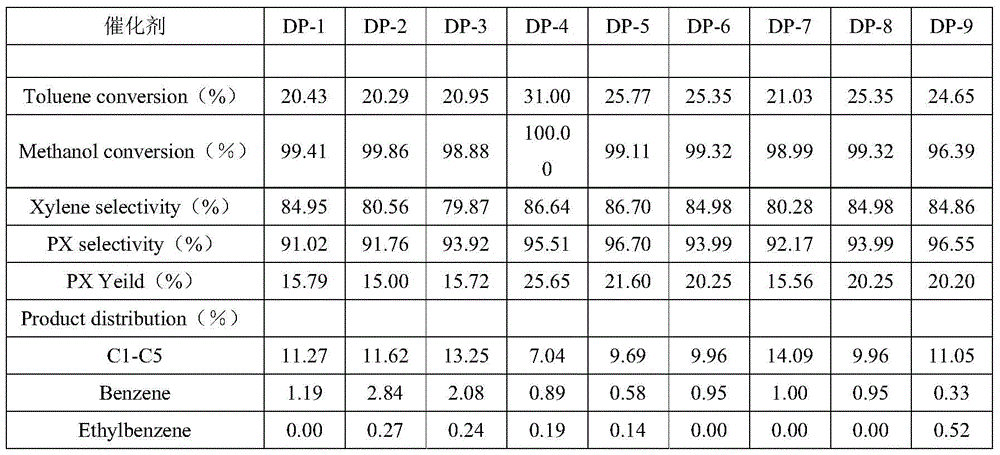Toluene methanol alkylation to produce p-xylene fluidized bed catalyst and preparation method thereof
A xylene fluidized bed and catalyst technology, applied in the chemical industry, can solve the problems of difficult industrialization, high cost and high energy consumption, and achieve the effects of easy wastewater treatment, low equipment requirements and low energy consumption
- Summary
- Abstract
- Description
- Claims
- Application Information
AI Technical Summary
Problems solved by technology
Method used
Image
Examples
preparation example Construction
[0033] The present invention also relates to a method for preparing a fluidized-bed catalyst for producing p-xylene through the alkylation of toluene with methanol, comprising the following steps:
[0034] a) Mix 20-70wt% ZSM-5 molecular sieve, 20-60wt% matrix, 5-50wt% binder and water to form a slurry with a solid content of 10-50% for spray molding to form a particle diameter Spherical particles between 10-300μm, calcination at 350-600°C for 2-20h to form the original powder;
[0035]b) Mix the original powder obtained in step a) with the aqueous solution of the modified element precursor in equal volumes, the mass of the precursor is 0-15wt% of the original powder by the amount of Mg, Ca, and Sr introduced, and the amount of P is 0-15wt% of the original powder. 0-10wt% of the mass and 0-10wt% of the mass of La and Ce accounted for the mass of the original powder. Under the condition of 10-90°C, impregnated and modified for 1-24h, the obtained material was dried and then roa...
Embodiment 1
[0039] 21.36kg demineralized water, 5.21kg ZSM-5 molecular sieve (SiO 2 / Al 2 o 3 The molar ratio is 20), 5.64kg of pseudo-boehmite, 7.79kg of silica sol, mixed, stirred for 2 hours, and then spray-dried to obtain microsphere particle products. The product is calcined at 500°C for 5 hours in an air atmosphere to obtain the original catalyst powder.
[0040] Stir 400g of the above catalyst raw powder, 112.9g of phosphoric acid, and 187.1g of water evenly, keep the temperature at 10°C for 24h, dry, and calcinate at 500°C for 5h to obtain a P-modified catalyst. Stir 400g of P-modified catalyst and 300g of tetramethylsilicate evenly, let it stand at room temperature for 1 hour, dry it, and roast it at 400°C for 6 hours to obtain P and Si-modified catalyst (referred to as DP-1).
Embodiment 2
[0042] 21.52kg demineralized water, 10.64kg ZSM-5 molecular sieve (SiO 2 / Al 2 o 3 The molar ratio is 25), 3.29kg of montmorillonite, 4.55kg of aluminum sol, mixed, stirred for 2 hours, and then spray-dried to obtain microsphere particle products. The product is calcined at 600°C for 2 hours in an air atmosphere to obtain the original catalyst powder.
[0043] 400g of the above-mentioned catalyst raw powder, 20g of lanthanum nitrate, and 280g of water were stirred evenly, kept at a constant temperature of 30°C for 15h, dried, and calcined at 350°C for 10h to obtain a La-modified catalyst. Stir 400g of La modified catalyst, 150g of phenylmethylpolysiloxane, and 150g of absolute ethanol evenly, let stand at room temperature for 10h, dry, and roast at 650°C for 2h to obtain La and Si modified catalyst (referred to as DP -2). Example 3
PUM
 Login to View More
Login to View More Abstract
Description
Claims
Application Information
 Login to View More
Login to View More - R&D
- Intellectual Property
- Life Sciences
- Materials
- Tech Scout
- Unparalleled Data Quality
- Higher Quality Content
- 60% Fewer Hallucinations
Browse by: Latest US Patents, China's latest patents, Technical Efficacy Thesaurus, Application Domain, Technology Topic, Popular Technical Reports.
© 2025 PatSnap. All rights reserved.Legal|Privacy policy|Modern Slavery Act Transparency Statement|Sitemap|About US| Contact US: help@patsnap.com


